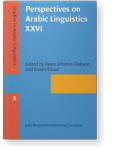Usama Soltan
List of John Benjamins publications for which Usama Soltan plays a role.
Journal
ISSN 2950-1806 | E-ISSN 2950-1792
Title
Perspectives on Arabic Linguistics XXVII: Papers from the Annual Symposium on Arabic Linguistics, Bloomington, Indiana, 2013
Edited by Stuart Davis and Usama Soltan
[Studies in Arabic Linguistics, 3] 2016. xvii, 238 pp.
Subjects Afro-Asiatic languages | Theoretical linguistics
2020 On the syntax of correlation: Evidence from Egyptian Arabic Perspectives on Arabic Linguistics XXXII: Papers selected from the Annual Symposium on Arabic Linguistics, Tempe, Arizona, 2018, Gelderen, Elly van (ed.), pp. 71–108 | Chapter
The goal of this paper is to describe and analyze the syntax of two types of correlation structures (CSs) in Egyptian Arabic (EA): A structure introduced by the quantifier kull (‘every’), and another introduced by the measure PP ʕalā Ɂadd (literally, ‘on/by amount’). More specifically, it is… read more
2016 Introduction Perspectives on Arabic Linguistics XXVII: Papers from the Annual Symposium on Arabic Linguistics, Bloomington, Indiana, 2013, Davis, Stuart and Usama Soltan (eds.), pp. xi–xvii | Article
2016 On the syntax of exceptive constructions in Egyptian Arabic* Perspectives on Arabic Linguistics XXVII: Papers from the Annual Symposium on Arabic Linguistics, Bloomington, Indiana, 2013, Davis, Stuart and Usama Soltan (eds.), pp. 35–57 | Article
The goal of this paper is twofold: First, it provides a descriptive account of the syntactic properties of Egyptian Arabic exceptive phrases headed by the particle ʔillaa. Second, it proposes an analysis of these syntactic properties in terms of Hoeksema’s (1987) seminal distinction between… read more
2014 On negative concord in Egyptian and Moroccan Arabic Perspectives on Arabic Linguistics XXIV–XXV: Papers from the annual symposia on Arabic Linguistics. Texas, 2010 and Arizona, 2011, Farwaneh, Samira and Hamid Ouali (eds.), pp. 159–180 | Article
The aim of this paper is threefold: First, we provide a descriptive account of the facts of negative concord (nc) in both Egyptian and Moroccan Arabic, showing how the two dialects are similar, and how they differ in this regard. Second, we discuss previous analyses of nc and how they fare in… read more
2014 On the distribution and licensing of polarity-sensitive items in Egyptian Arabic: The cases of ʔayy and walaa Perspectives on Arabic Linguistics XXIV–XXV: Papers from the annual symposia on Arabic Linguistics. Texas, 2010 and Arizona, 2011, Farwaneh, Samira and Hamid Ouali (eds.), pp. 181–206 | Article
The goal of this paper is twofold: First, to provide a descriptive account of the grammatical distribution and behavior of the two Egyptian Arabic (ea) polarity-sensitive items (psis) ʔayy (= ‘any’) and walaa (a negative element used in negative concord structures); second, to discuss the… read more
2014 Splitting Neg: The morphosyntax of sentential negation in Cairene Egyptian Arabic revisited Perspectives on Arabic Linguistics XXVI: Papers from the annual symposium on Arabic Linguistics. New York, 2012, Khamis-Dakwar, Reem and Karen Froud (eds.), pp. 91–120 | Article
The goal of this paper is to revisit sentential negation patterns in Cairene Egyptian Arabic and propose a novel analysis for their morphosyntactic properties in this Arabic dialect. In particular, it is argued that the distribution of negation patterns takes place in the mapping from the syntax to… read more
2007 On agree and postcyclic merge in syntactic derivations: First conjunct agreement in standard Arabic Perspectives on Arabic Linguistics: Papers from the annual symposium on Arabic Linguistics, Benmamoun, Elabbas (ed.), pp. 191–213 | Article
2007 On the individual-property contrast in free state possessive nominals in Egyptian Arabic Perspectives on Arabic Linguistics: Papers from the annual symposium on Arabic linguistics, Mughazy, Mustafa A. (ed.), pp. 71–86 | Article
2006 Standard Arabic subject-verb agreement asymmetry revisited in an Agree-based minimalist syntax Agreement Systems, Boeckx, Cedric (ed.), pp. 239–265 | Article






